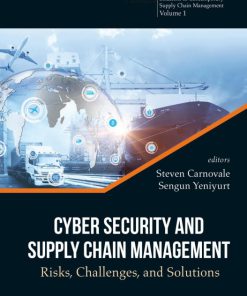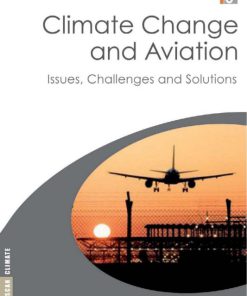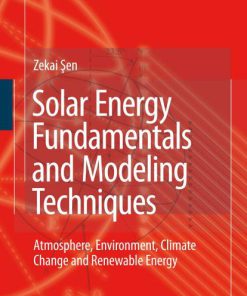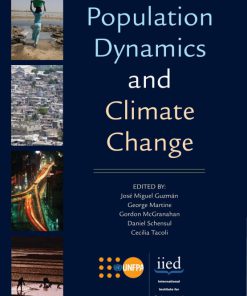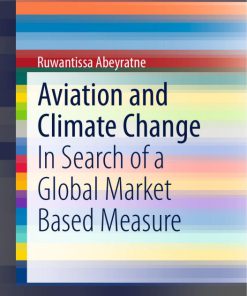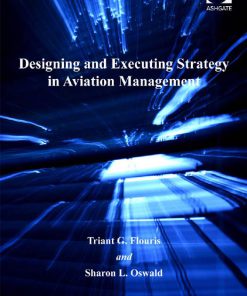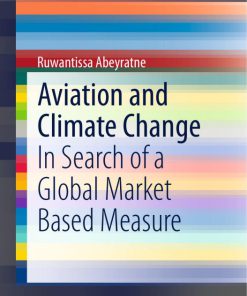Climate Change and Aviation Issues Challenges and Solutions 1st edition by Stefan Gössling,Paul Upham 1136569669 9781136569661
$50.00 Original price was: $50.00.$25.00Current price is: $25.00.
Authors:Stefan Gössling; Paul Upham , Series:International Relation [23] , Author sort:Gössling, Stefan & Upham, Paul , Languages:Languages:eng , Published:Published:Feb 2009 , Publisher:Earthscan
Climate Change and Aviation Issues Challenges and Solutions 1st edition by Stefan Gössling,Paul Upham- Ebook PDF Instant Download/Delivery.9781136569661,1136569669
Full download Climate Change and Aviation Issues Challenges and Solutions 1st edition after payment

Product details:
ISBN 10:1136569669
ISBN 13:9781136569661
Author:Stefan Gössling,Paul Upham
‘This is a timely, challenging and fascinating book on a topic of central importance to the success or otherwise of our climate change policies. It sets down a clear marker for what has to be done in the aviation sector.’ Professor John Whitelegg, Stockholm Environment Institute, University of York, UK ‘Climate Change and Aviation presents a clear picture of the transport sector’s greatest challenge: how to reconcile aviation’s immense popularity with its considerable environmental damage and its dependence on liquid hydrocarbon energy sources. This book avoids wishful thinking and takes the much harder, but more productive, path of considering difficult solutions that clash with short-term and short-sighted expectations about the unlimited growth potential for flying.’ Professor Anthony Perl, Urban Studies Program, Simon Fraser University, Canada ‘A convincing and timely collection that brings together an impressive range of expertise. The book integrates various perspectives into a powerful core argument – we must do something, and quickly, to tackle the impact of aviation on our environment. The authors recognise the political difficulties associated with promoting change but present constructive options for policy makers. Required reading, especially for transport ministers set on promoting the growth of air travel.’ Professor Jon Shaw, Director of the Centre for Sustainable Transport, University of Plymouth, UK Trends such as the massive growth in availability of air travel and air freight are among those which have led to aviation becoming one of the fastest growing emitters of greenhouse gases. These trends have also caused a shift in expectations of how we do business, where we go on holiday, and what food and goods we can buy. For these reasons aviation is (and is set to stay) high up on global political, organizational and media agendas. This textbook is the first to attempt a comprehensive review of the topic, bringing together an international team of leading scientists. Starting with the science of the environmental issues, it moves on to cover drivers and trends of growth, socio-economics and politics, as well as mitigation options, the result being a broad yet detailed examination of the field. This is essential reading for undergraduate and postgraduate courses in transport, tourism, the environment, geography and beyond, while also being a valuable resource for professionals and policymakers seeking a clear understanding of this complex yet urgently pressing issue.
Climate Change and Aviation Issues Challenges and Solutions 1st Table of contents:
1 Introduction: Aviation and Climate Change in Context
The age of aviation
Aviation and climate change
Turbulent times ahead: Emission trading and oil prices
The need for an integrated perspective
Part I Aviation and Atmosphere
Part II Drivers and Trends
Part III Socio-economics and Politics
Part IV Mitigation
Note
References
Part I Aviation and Atmosphere
2 Aviation and Climate Change: The Science
Introduction
Emission trends
Climate concepts and metrics
Effects of aviation on radiative forcing and climate
Overview
Carbon dioxide
Effects of nitrogen oxides on ozone and methane
Water vapour
Particles – sulphate, black carbon, organic
Persistent linear contrails and aircraft-induced cirrus
Overall RF and climate response from aviation
Mitigation: Technological and policy options and the complication of the atmosphere
Technology
Conclusions
Acknowledgements
References
3 Calculating Emissions and Radiative Forcing
The quest for metrics and data
Carbon dioxide emissions
Emission inventories
Fleet or route emission
Radiative Forcing
Gwp
Rfi
Agwp
Methodological recommendations
Conclusions and research recommendations
References
4 Aviation in a Low-carbon EU
Introduction
Global climate targets
Aviation trends
Eu Emissions Trading Scheme
Carbon budgets
Aviation emission scenarios
Aviation emission baselines
Short-term
Medium to long term
Economic analysis
Discussion and conclusions
Current aviation emissions are significant
Eu aviation scenarios within a 450ppmv budget
Aviation remains privileged
Conclusion
Notes
References
Part II Drivers and Trends
5 Low-cost Aviation
Introduction
From regulation to open skies
The emergence of low-cost carriers
The business model of low-cost airlines
Effects on demand and traffic
The destination perspective
Conclusion: Low-cost aviation – a Janus-faced business
References
6 Hypermobile Travellers
Introduction
Evidence of hypermobility
Who are the hypermobile travellers? A case study in France
The emergence of hypermobile travel patterns
Conclusions: Hypermobility and climate change
Note
References
7 Airline Trends in Europe: Network Consolidation and the Mainstreaming of Low-cost Strategies
Introduction
Changes in long-haul coverage
Dependence upon a single airline or alliance group
Potential winners and losers among European cities and airports from international airline alliance formation
Future of the global alliances and implications for European hubs
Airline service at second-tier cities
Airline restructuring
Raising labour productivity and outsourcing more services
More use of regional aircraft
Revising pricing and removing minimum stays on low fares
Charging for catering or reducing free provision
Abandoning business class
Reducing distribution costs
Increasing aircraft utilization
Setting up a low-cost subsidiary
Conclusions
Note
References
Part III Socio-economics and Politics
8 Aeropolitics and Economics of Aviation Emissions Mitigation
Introduction
Aeropolitics: An introduction and review
The economics of airline networks
Aviation and emissions
Politics, public policy and aviation emissions: The EU ETS
Conclusion
References
9 Aviation and Economic Development: The Implications of Environmental Costs on Different Airline Business Models and Flight Networks
Introduction
Engine emission charges at airports
Environmental charge mechanism: A generic systematic approach
Methods for estimating engine emissions and noise social costs
Engine emission social costs
Noise social costs
The impacts of environmental costs on air-passenger demand for different airline business models
Market selection
Aircraft engine emissions and noise social costs for the cases
Air fares and demand elasticities
Empirical results
Summary
The environmental costs of two patterns of airline service, hub-to-hub and hub bypass
Hub-and-spoke versus direct flight
Market selection
Aircraft engine emission and noise social costs for the cases
Empirical results
Summary
The implications of aircraft engine emissions costs on the operating costs of Asian airlines
Market selection
Aircraft engine emission social costs for the cases
Implications for airline operating costs
Summary
Conclusions
Notes
References
10 Air Freight: Trends and Issues
Introduction: The increased importance of air freight
The global value chain of air freight
Changing general conditions: Customer requirements, new technologies and deregulation
Freight forwarders, airlines and integrators: Participants in the goods chain
World traffic junctions: Airports
Air freight, reorganizing and traffic: A case study
Conclusions: Air freight and climate change
Acknowledgement
Notes
References
11 Practice(s) and Ratchet(s): A Sociological Examination of Frequent Flying
Introduction
The context of UK emissions reduction targets and aviation growth
Practice theory and (un)sustainable consumption
Applying, extending, developing practice theory: The specific case of frequent flying
Trophy tourism
Last-chance tourism
When the exotic becomes everyday, and flying becomes routine, we come full circle to ordinary consumption
Groups on the move
Coming home – to talk or not to talk?
Travel bores?
The rising norms and standards of occasion and celebration
Flying trends: Exotic and mundane, but still the preserve of the rich
Frequent holidaying
Short breaks
Activity holidays
Ratchets
Ratcheting up?
First fly
Budget airlines and penny flights
Schools standards and curricula
Ratcheting down?
(Dis)comfort and the flying experience
Upper limits
Discourses of environmental concern
Conclusions and implications for theory and climate policy
References
12 Aviation Coalitions: Drivers of Growth and Implications for Carbon Dioxide Emissions Reduction
Introduction
Growth coalitions: Governance for aviation expansion
A national aviation growth agenda
Commissioning an economic case for expansion
Strategic use of airport master plans
Assistance from local authorities and agencies
Sectoral partnerships
Industry-wide environmental performance
Capacity constraint relief projects
Single technology innovations
Evidence of coalitions in aviation discourse
Aviation growth equals economic growth
Technological innovation equals reduced climate change impacts
‘EU ETS good (if properly designed), APD bad’
Cooperation and conflict in the coalition
Addressing the environmental agenda: Sustaining aviation, not sustainable aviation
Conclusion
Acknowledgements
Notes
References
Part IV Mitigation
13 Technical and Management Reduction Potentials
Introduction
History and future of aviation fuel efficiency
Historical analysis of fuel efficiency
Fuel efficiency forecast
Limitations of aircraft technology
Identification of some promising technologies1
Development and fleet renewal
Growth in air travel demand
Obstacles and impediments
Operational measures to reduce radiative forcing
Improving fuel efficiency using air traffic management measures
Reducing radiative impacts of aviation through cruise altitude selection
Eco-efficiency and a strategy for air transport
Conclusions
Note
References
14 Biofuels, Aviation and Sustainability: Prospects and Limits
Introduction
Climate change context
Non-biofuel alternatives to mineral kerosene
Biodiesel and biokerosene
Is there enough land?
Land for carbon sequestration
Land for biofuel production
Should we produce biofuel on this scale?
The environmental performance of biofuels
Energy balance
Environmental impacts
The role of sustainability certification
Making a decision on biofuels
Conclusions
Notes
References
15 Voluntary Carbon Offsetting for Air Travel
Introduction
Outline of voluntary carbon markets
Producing carbon commodities
Emissions credit standards
Project types, sizes and locations
Consuming carbon credits
Problems with offsetting
Issues with projects and project type
Criticisms of offsetting in principle
Conclusions
References
16 Aviation and Climate Change: Assessment of Policy Options
Introduction
The context of aviation and climate policy
Types of policy approach
Regulatory approaches
Market-based approaches
Environmental taxes
Emissions charges
Subsidies
Tradable permits
Voluntary measures
Evaluation of policy options
Conclusion
References
17 Conclusion
People also search for Climate Change and Aviation Issues Challenges and Solutions 1st:
climate change and aviation issues challenges and solutions
climate change and aviation sustainability
climate change and aviation safety
climate change and the impact of extreme temperatures on aviation
aviation and global climate change in the 21st century
You may also like…
eBook PDF
Population Dynamics and Climate Change 1st Edition by United Nations ISBN 089714919X 9780897149198



